Japan
Wood Products Prices
Dollar Exchange Rates of 25th
Jan
2023
Japan Yen 148.16
Reports From Japan
No change in Bank of
Japan policy
As anticipated the Bank of Japan (BoJ) left its negative
policy rate unchanged due, in part, to uncertainty over how
the magnitude 7.6 earthquake that struck Ishikawa
Prefecture on 1 January will impact the economy.
Observers are closely watching for when the BoJ will start
exiting negative rates and get Japan back and in cinque
with the rest of the world.
See:
https://asia.nikkei.com/Economy/Bank-of-Japan/BOJ-chief-vows-to-limit-disruption-after-raising-policy-shift-hopes
Relief as cost of imports decline
Japan’s customs-cleared trade deficit halved from the
previous year to yen 9.29 trillion in 2023 after lower
resource prices pulled down the value of imports
according to the Ministry of Finance Ministry. Japan
reported a trade deficit for the third straight year but the
2023 deficit was down from the yen 20.3 trillion in 2022.
In 2023 imports dropped 7.0% as imported energy costs
fell.
See:
https://japannews.yomiuri.co.jp/business/economy/20240124-164306/
OECD calls for boost in productivity
A press release from the OECD points out that
Japan’s economy has recovered from
the Covid pandemic but faces new
challenges from weak global trade prospects. Saying,
policy should now focus on ensuring fiscal
sustainability, boosting productivity growth and
addressing the economic and social impacts
of rapid population ageing. The latest OECD Economic
Survey of Japan says that GDP grew by 1.9% in
2023 and will continue to steadily grow by 1.0% in 2024
and 1.1% in 2025, mostly driven by domestic demand as
global uncertainty weighs on external demand.
Consumer price inflation is projected to slowly come
down to 2.6% in 2024, from 3.2% in 2023 and stabilise
at 2% in 2025 as government subsidies end and wage
growth gains traction.
The positive outcome of the 2023 wage negotiations, the
highest in three decades, points towards a virtuous
cycle where rising prices contribute to growing wages and
consumption.
The OECD warned that uncertainty around Japan’s
inflation outlook was “exceptionally large.” While a
slowdown in the global economy could weigh on wages, a
tighter labour market could lead to higher-than-projected
wage growth, it said.
Capital spending trending lower
Capital spending by the private sector is one of the key
drivers of Japan's economy and a major indicator of
business confidence. According to Cabinet Office data
machinery orders fell 4.9% in November from the
previous month underscoring the uncertainty about
domestic and global economic outlook.
Year-on-year, core orders, which excludes shipping and
power utilities, declined 5.0% versus a forecast for 0.2%
growth. In response the government retained its view that
machinery orders had "stalled" for 13 straight months.
Orders from manufacturers fell 7.8% in November from
the previous month, pulled down by a drop in orders for
general-purpose production machinery.
See:
https://www.japantimes.co.jp/business/2024/01/18/economy/japan-machinery-orders-fall/
Rate of inflation slowing
According to the Ministry of Internal Affairs and
Communications, the consumer price index in Japan
climbed 3.1% in 2023 marking its biggest gain since 1982.
The rise was largely caused by rising food costs and the
high cost of imports because of the weakening yen
exchange rate.
The December's data showed a slight slowing in the pace
of inflation as the pace of cost domestic logistics and
labour costs eased. The inflation data is in support of
government calls for businesses to raise wages.
See:
https://japannews.yomiuri.co.jp/business/economy/20240119-163039/
In related news, a private think tank estimates Japanese
companies will need to raise wages by around 4% this
year to keep real wages from falling, this will be tough for
smaller businesses struggling to pass on higher costs to
customers. Year on year, November nominal wages
increased by just 0.2% according to the Ministry of
Health, Labor and Welfare while. Consumer prices rose by
3.3% over the same span, resulting in a 3% decline in real
wages. The wage increase for companies with 1,000 or
more employees in 2023 was 3.6%, according to the
Minstry.
https://asia.nikkei.com/Economy/Japan-s-pay-needs-to-grow-3.6-to-outpace-inflation-think-tanks-say?utm_campaign=GL_JP_update&utm_medium=email&utm_source=NA_newsletter&utm_content=article_link
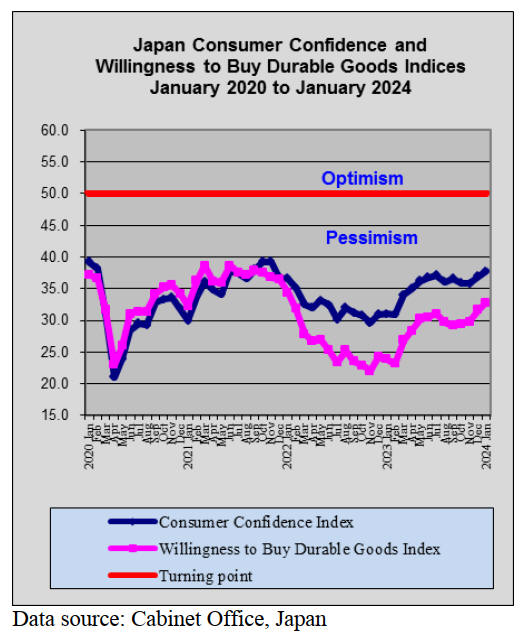
Business federation says businesses have a social
responsibility to raise wages
Business executives and union leaders across Japan have
begun wage negotiations for the new fiscal year. High
price inflation and strong corporate earnings has raised
hopes for major pay increases.
The Japan Business Federation (Keidanren) recently held
its annual labour and management meeting at which the
chairman, Masakazu Tokura, said that companies "have a
social responsibility" to raise wages so they keep up with
inflation.
The Japanese Trade Union Confederation (Rengo) wants
at least a 5% increase for its members this year. Last year's
wage negotiations resulted in an average wage increase of
about 3.6%, a 30-year high.
See:
https://mainichi.jp/english/articles/20240125/p2a/00m/0op/008000c
Two months needed to assess quake damaged homes
Work has started on assessing the damage caused to
homes by the powerful Noto Peninsula Earthquake in
Ishikawa Prefecture. The assessments are required for the
issuance of a disaster victim certificate which is used to
calculate the amount of financial support the central
government and others will provide to victims of the
disaster.
About 30,000 buildings in Wajima alone need to be
assessed, a process which the city government estimates
will take two months to complete.
According to the prefectural government, it has
determined (as of 19 January) that 29,489 homes in
Ishikawa had been damaged. This does not include homes
in Wajima and Suzu, the two cities that experienced the
worst of the earthquake.
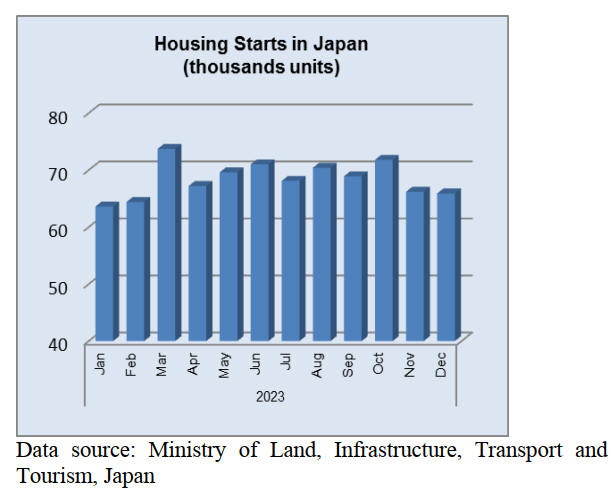
Yen continues to weaken
Towards month end the US dollar fell against the Japanese
yen after the Bank of Japan maintained its ultra-easy
policy as expected but signaled an April exit from negative
interest rates.
However, the dollar then gained against the yen. The yen
exchange rate is sensitive to differentials between Japan
and other major currencies and has lost nearly 5% against
the dollar this year.

Import update
Assembled wooden flooring imports
In November the main category of assembled flooring
imports was HS441875 accounting for just over 70% of
the total value of assembled flooring imports. The second
largest category in terms of value was HS441879.
The main shippers of HS441875 in November were China
42%, down slightly from a month earlier, Malaysia (8%)
along with Austria and Lithuania also at around 8% each.
The value of Japan’s November imports of assembled
flooring (HS441871-79) dropped slightly (6%) compared
to the value of October arrivals. Year on year the value of
November assembled flooring imports rose around 7%.
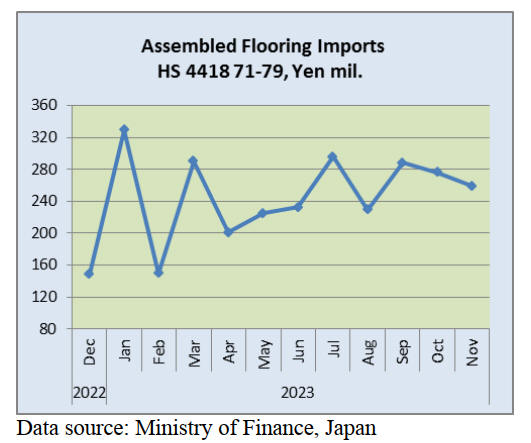
Plywood imports
There was a sharp turn-around in the volume of plywood
imports in November. Compared to a month earlier
November imports were 16% higher than in October and
year on year November import volumes jumped 15%.
Of the two main shippers, Malaysia and Indonesia, it was
only Malaysian shippers that scored in November and
Malaysian exports in November were almost entirely the
reason for the jump in monthly import volumes.
The volume of imports from Indonesia, Vietnam and
China in November were little changed from a month
earlier.
Plywood imports began to recover in 2021 and were fairly
consistent in the first half of 2022 but the combined effect
of the weak yen and a dull housing market resulted in a
slowing of imports, a trend that continued until mid 2023.
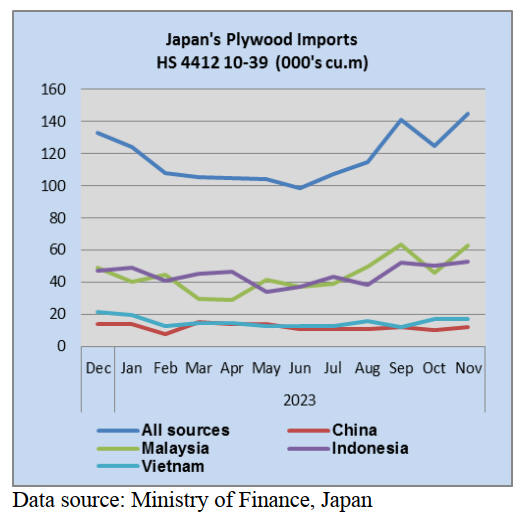 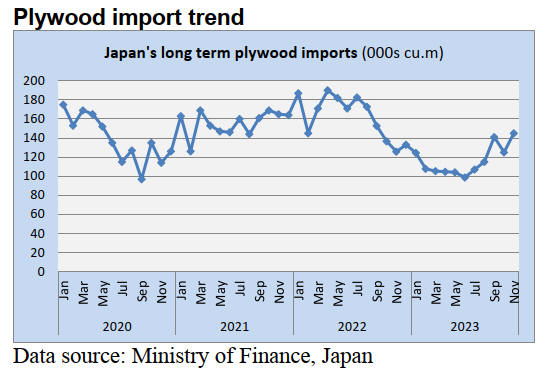
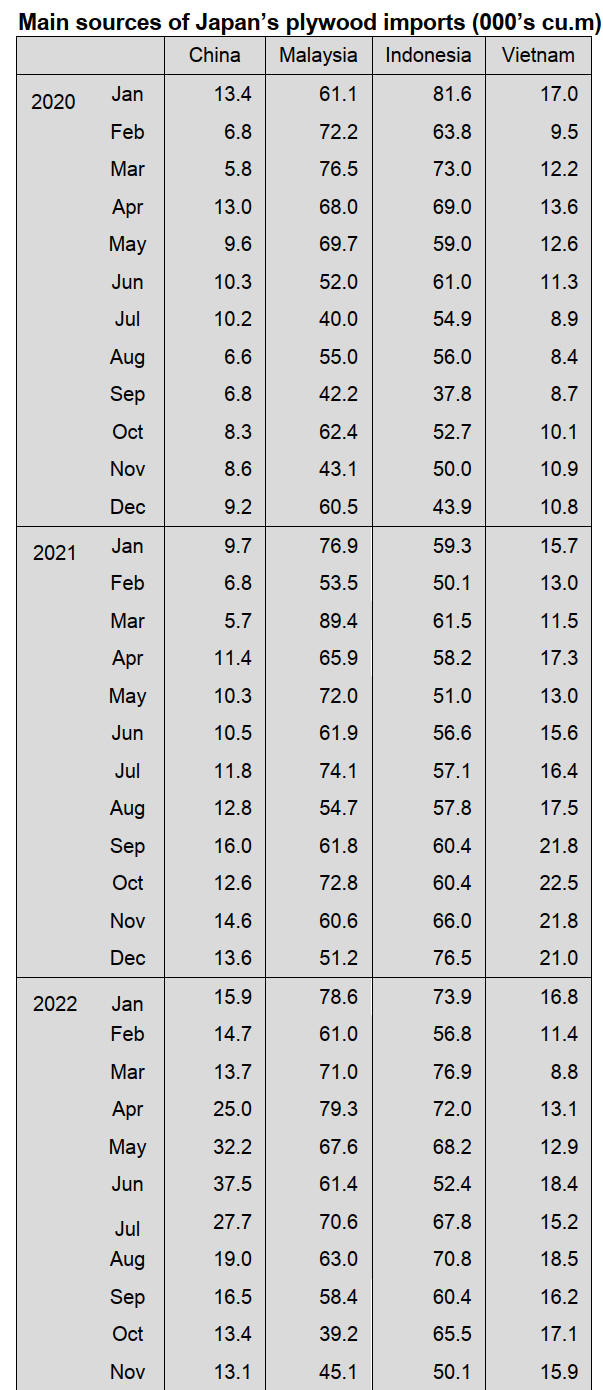 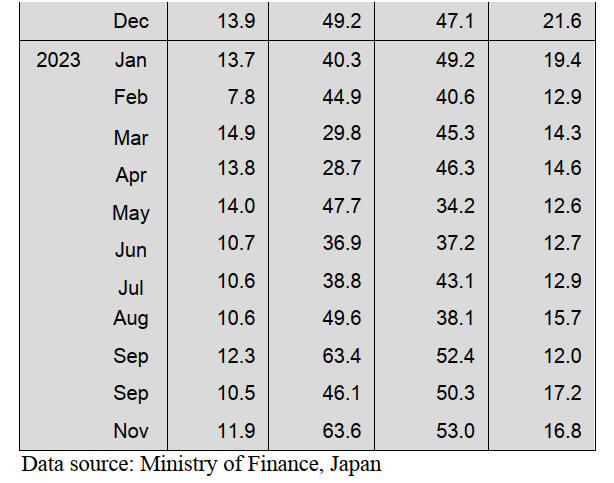
Trade news from the Japan Lumber Reports (JLR)
The Japan Lumber Reports (JLR), a subscription trade
journal published every two weeks in English, is
generously allowing the ITTO Tropical Timber Market
Report to reproduce news on the Japanese market
precisely as it appears in the JLR.
For the JLR report please see:
https://jfpj.jp/japan_lumber_reports/
Domestic logs and lumber
Movement of domestic lumber settled down after the New
Year holiday. Usually, movement of domestic lumber is
very slow in January to March due to low demand.
An operating rate at some precutting plants has decreased
by 60 – 70 %. Then, there were not a lot of inquiries at
lumber markets. Demand and supply for logs in the
northern part of Kanto region are balanced now. KD cedar
post was around 65,000 yen, delivered per cbm in
December, 2023 and the price is 63,000 – 65,000 yen,
delivered per cbm now except Western Japan. KD cedar
stud is around 65,000 yen and this is leveled off.
Cypress sills and cypress logs were 85,000 yen in
December, 2023 and they are 80,000 – 85,000 yen now.
Demand and supply for logs and lumber are different in
several areas in Japan. For example, there are a lot of
inquiries for cypress lumber instead of Douglas fir lumber
in Kyushu region and Chubu region. However, there are
not enough cypress logs.
In Shikoku region, cypress logs are popular and the price
of 4 m cypress log is around 25,000 yen. Cedar logs used
to be around 10,000 yen but the price of 3 m cedar logs is
around 12,000 yen. 4 m cedar logs are around 15,000 yen.
The price of cypress logs is around 22,000 yen in
Kumamoto Prefecture and this price decreased from
26,000 yen last autumn. 3 m cedar log is around 17,000
yen. The price of 3 m cedar log in the northern part of
Kanto region is around 16,000 yen.
In related news, a supplementary budget for
measures of
afforesting forest with less pollen is six billion yen and
one of measures becomes clear.
The measure is to support forest owners to
outsource
logging and transplanting to forestry organizations. Also,
the Ministry of Agriculture, Forestry and Fisheries will
deliver promotion expenses for transplanting to forest
owners.
Plywood
There was shipment of domestic softwood plywood from
trading companies and wholesalers during last autumn till
the end of 2023. On the other hand, shipment of structural
plywood is bearish. 12 mm 3 x 6 structural plywood is
1,450 – 1,480 yen, delivered to wholesalers per sheet and
it is 20 yen lower than the previous month. A decrease in
the price settled down. Also, consumers hesitate to request
the plywood companies in Ishikawa Prefecture to lower
the price because there was a huge earthquake in January,
2024 and plywood plants are unable to produce plywood.
Some South Asian shippers raised the price of South Sea
plywood because the log price has been rising in South
Asia. 2.4 mm 3 x 6 plywood is around US$950, C&F per
cbm. 3.7 mm plywood is around US$880, C&F per cbm.
5.2 mm plywood is around $ 850, C&F per cbm. Form
plywood is around US$580, C&F per cbm. Structural
plywood is US$500– 570, C&F per cbm. 12 mm 3 x 6
painted plywood for concrete form is US$670 – 680, C&F
per cbm. The prices are almost the same prices from last
month.
Since the yen had depreciated against the dollar until last
autumn, Japanese sellers expect to raise the price of South
Sea plywood.
However, once, the yen appreciated to 140 yen against the
dollar in December, 2023 and the movement of domestic
softwood plywood was bearish so it is difficult for
distributors to raise the price. 2.5 mm plywood is 780 yen,
delivered to wholesalers per sheet. 4 mm plywood is 1,000
yen, delivered to wholesalers per sheet. 5.5 mm plywood
is 1,200 yen, delivered to wholesalers per sheet.
Structural plywood is 1,800 yen, delivered to wholesalers
per sheet. 12 mm 3 x 6 painted plywood for concrete form
is 1,990 – 2,000 yen, delivered to wholesalers per sheet.
The receipt of South Sea plywood has been declining since
last year and the inventories at ports in Kanto area has
been declining. Some items are in short supply but some
trading companies or distributors are unable to order a
large amount of South Sea plywood. One of reasons is that
fiscal year-end is in March.
South Sea log and products
The price of South Sea logs in South Asia is still high. One
of the reasons is that a plywood company in Sarawak,
Malaysia reduced cutting down the trees. South Sea
lumber made in Japan is used as blocks for mainly steels
or shipbuilding. Consumers need durable South Sea
lumber such as Keruing to hold heavy materials.
The yen appreciated against the dollar at the end of 2023
and some Japanese distributors purchase South Sea lumber
and Chinese lumber.
However, Japanese distributors did not purchase a lot of
lumber because demand in Japan has been still low.
Merkusii pine lumber isUS$770 – 780, C&F per cbm in
Indonesia. Red pine lumber is US$790 – 820, C&F per
cbm in China. This is US$20 – 30 higher than the previous
time.
Chinese sellers will raise the price because there will be a
Chinese New Year holiday in the beginning of February,
2024. Since the rupiah is weak, Indonesian sellers are
unable to raise the price even though they expected to.
There has been some inquiries for decks. The inquiries for
truck bodies have been still firm.
North American logs
Trading companies and distributors in Japan are unable to
grasp the situation for the correct import cost of Doulgas
fir logs. Demand for Douglas fir lumber has been sluggish
in Japan and also there has been less inquiries for Douglas
fir lumber.
Usually, demand for all kinds of lumber in Japan is very
low in February and March so the distributors do not buy a
lot of lumber. In this season, consumers bought domestic
lumber or European lumber instead of Douglas fir lumber.
Radiata pine logs and lumber
Radiata pine logs shipped to Japan in December, 2023
from New Zealand are $ 170 – 175, C&F per cbm. This is
US$10 higher than November, 2023. According to the
Japanese importers, the log price wasUS$15, C&F per
cbm higher than the previous time but the freight declined
slightly from the previous time. That is the reason for $ 10
up.
The log price for Chin is around $ 130, C&F per cbm and
this is US$5 – 10, C&F per cbm higher than last time so
shippers in NZ were very aggressive about the price hike
to Japanese importers.
The negotiation for radiata pine lumber from Chili in
February, 2024 ended in the middle of January, 2024. Thin
boards and squares areUS$350 – 355, C&F per cbm and
the prices are stabilized from last time. Wholesalers in
Japan decided not to raise the price because the price of
radiata pine lumber is unchanged from last time and the
yen appreciated against the dollar temporary.
|